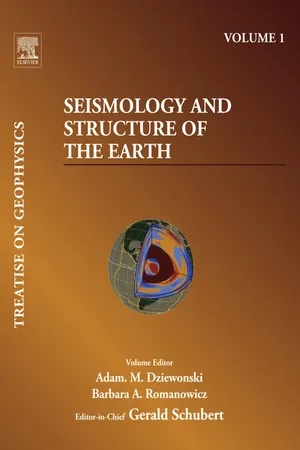
eBook - PDF
Seismology and Structure of the Earth
Treatise on Geophysics
- 7,000 pages
- English
- PDF
- Available on iOS & Android
eBook - PDF
About this book
Treatise on Geophysics: Seismology and Structure of the Earth, Volume 1, provides a comprehensive review of the state of knowledge on the Earths structure and earthquakes. It addresses various aspects of structural seismology and its applications to other fields of Earth sciences. The book is organized into four parts. The first part principally covers theoretical developments and seismic data analysis techniques from the end of the nineteenth century until the present, with the main emphasis on the development of instrumentation and its deployment. The second part reviews the status of knowledge on the structure of the Earths shallow layers, starting with a global review of the Earth's crustal structure. The third part focuses on the Earth's deep structure, divided into its main units: the upper mantle, the transition zone and upper-mantle discontinuities, the D region at the base of the mantle, and the Earth's core. The fourth part comprises two chapters which discuss constraints on Earth structure from fields other than seismology: mineral physics and geodynamics.
- Self-contained volume starts with an overview of the subject then explores each topic with in depth detail
- Extensive reference lists and cross references with other volumes to facilitate further research
- Full-color figures and tables support the text and aid in understanding
- Content suited for both the expert and non-expert
Frequently asked questions
Yes, you can cancel anytime from the Subscription tab in your account settings on the Perlego website. Your subscription will stay active until the end of your current billing period. Learn how to cancel your subscription.
At the moment all of our mobile-responsive ePub books are available to download via the app. Most of our PDFs are also available to download and we're working on making the final remaining ones downloadable now. Learn more here.
Perlego offers two plans: Essential and Complete
- Essential is ideal for learners and professionals who enjoy exploring a wide range of subjects. Access the Essential Library with 800,000+ trusted titles and best-sellers across business, personal growth, and the humanities. Includes unlimited reading time and Standard Read Aloud voice.
- Complete: Perfect for advanced learners and researchers needing full, unrestricted access. Unlock 1.4M+ books across hundreds of subjects, including academic and specialized titles. The Complete Plan also includes advanced features like Premium Read Aloud and Research Assistant.
We are an online textbook subscription service, where you can get access to an entire online library for less than the price of a single book per month. With over 1 million books across 1000+ topics, we’ve got you covered! Learn more here.
Look out for the read-aloud symbol on your next book to see if you can listen to it. The read-aloud tool reads text aloud for you, highlighting the text as it is being read. You can pause it, speed it up and slow it down. Learn more here.
Yes! You can use the Perlego app on both iOS or Android devices to read anytime, anywhere — even offline. Perfect for commutes or when you’re on the go.
Please note we cannot support devices running on iOS 13 and Android 7 or earlier. Learn more about using the app.
Please note we cannot support devices running on iOS 13 and Android 7 or earlier. Learn more about using the app.
Yes, you can access Seismology and Structure of the Earth by Barbara Romanowicz,Adam Dziewonski in PDF and/or ePUB format, as well as other popular books in Physical Sciences & Geology & Earth Sciences. We have over one million books available in our catalogue for you to explore.
Information
Topic
Physical SciencesSubtopic
Geology & Earth SciencesTable of contents
- Cover
- SEISMOLOGY AND STRUCTURE OF THE EARTH
- Copyright page
- Table of Contents
- Preface
- Contributors
- Editorial Advisory Board
- Chapter 1 Overview
- Chapter 2 Theory and Observations – Earth’s Free Oscillations
- Chapter 3 Theory and Observations – Normal Modes and Surface Wave Measurements
- Chapter 4 Theory and Observations – Body Waves: Ray Methods and Finite Frequency Effects
- Chapter 5 Theory and Observations – Forward Modeling/Synthetic Body Wave Seismograms
- Chapter 6 Theory and Observations – Forward Modeling and Synthetic Seismograms: 3-D Numerical Methods
- Chapter 7 Theory and Observations – Teleseismic Body-Wave Scattering and Receiver-Side Structure
- Chapter 8 Crust and Lithospheric Structure – Active Source Studies of Crust and Lithospheric Structure
- Chapter 9 Theory and Observations – Wave Propagation in Anisotropic Media
- Chapter 10 Theory and Observations – Seismic Tomography and Inverse Methods
- Chapter 11 Crust and Lithospheric Structure – Global Crustal Structure
- Chapter 12 Crust and Lithospheric Structure – Seismic Structure of Mid-Ocean Ridges
- Chapter 13 Crust and Lithospheric Structure – Hot Spots and Hot-Spot Swells
- Chapter 14 Crust and Lithospheric Structure – Natural Source Portable Array Studies of Continental Lithosphere
- Chapter 15 Crust and Lithospheric Structure – Long Range Controlled Source Seismic Experiments in Europe
- Chapter 16 Deep Earth Structure – Upper Mantle Structure: Global Isotropic and Anisotropic Elastic Tomography
- Chapter 17 Deep Earth Structure – Transition Zone and Mantle Discontinuities
- Chapter 18 Deep Earth Structure – Lower Mantle and D0
- Chapter 19 Deep Earth Structure – The Earth’s Cores
- Chapter 20 Deep Earth Structure – Seismic Scattering in the Deep Earth
- Chapter 21 Deep Earth Structure – Q of the Earth from Crust to Core
- Chapter 22 Constraints on Seismic Models from Other Disciplines – Constraints from Mineral Physics on Seismological Models
- Chapter 23 Constraints on Seismic Models from Other Disciplines – Implications for Mantle Dynamics and Composition